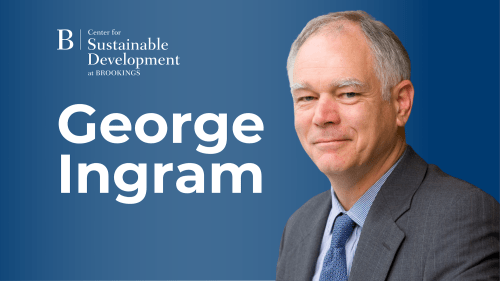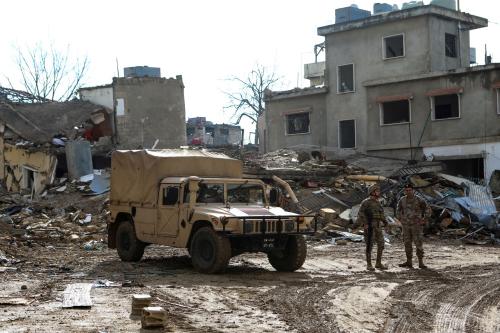As the United States sought in recent weeks to assemble an international coalition to combat the Islamic State of Iraq and al-Sham (ISIS, also known as the Islamic State), it looked mostly to the Middle East and Europe, regions that it said face a direct threat from the militant Islamist group. But other parts of the world are just as anxious about ISIS — above all, Southeast Asia. The governments of that region have not publicized their concerns very loudly, but they are acutely aware that ISIS is a menace. Their top concern is that its extremist ideology will prove attractive to the region’s many Muslims, lure some of them to the Middle East to fight as part of the group, and ultimately be imported back to the region when these militants return home.
There is a clear precedent for this scenario. During the 1980s, many young Muslims from Southeast Asia went to Pakistan to support the Afghan mujahideen’s so-called jihad against Soviet occupation. Many of these recruits subsequently stayed in the region, mingling with like-minded Muslims from all around and gaining exposure to al Qaeda’s militant ideology. Many eventually returned to Southeast Asia to form extremist groups of their own, including the notorious al Qaeda–linked organization Jemaah Islamiyah that was responsible for several high-profile terrorist attacks in the region over the last 15 years. With evidence now surfacing of Southeast Asians among the ranks of ISIS casualties, it’s only natural that governments in the region are feeling a sense of déjà vu.
Radical Chic
Singapore has already revealed that several of its nationals have made their way to the Middle East to battle with ISIS, and the Philippine government has suggested that local ISIS sympathizers are attempting to recruit from among the Bangsamoro populations in the country’s southern islands. But the greatest concern comes from Indonesia and Malaysia. Indonesia, the world’s most populous Muslim country, has already confirmed that more than 50 of its citizens are currently fighting in Syria and Iraq; Malaysia has suggested that between 30 and 40 Malaysians are doing the same. In both cases, the actual numbers could be much higher if we consider those who may have traveled to the conflict zones from other destinations. Indonesian authorities have already noted that several of their nationals have been killed fighting for ISIS in Syria. On May 26, a Malaysian suicide bomber killed himself in an ISIS attack in Iraq. Another Malaysian fighter who died fighting for ISIS in Syria several months later has been celebrated as a martyr by leaders of the Pan-Malaysian Islamic Party, the same party that had earlier dismissed him after he departed for Syria. Intriguingly, three Malaysian women were also alleged to have left for Syria to wage a “sexual jihad” (jihad al-nikah), offering their bodies to ISIS fighters to “boost their morale.”
ISIS’ reach in Southeast Asia is based on several factors. First, certain devout Muslims feel a theological affinity for the militant group. They see parallels between ISIS’ mission and prophecies in Islamic holy texts of the eventual creation of a Khilafah Minhaj Nebuwwah (“end-times caliphate”) following the fall of dictators in the Arabian Peninsula; they are also reminded of the apocalyptic struggle that is said to be fated between the forces of Imam Mahdi, an Islamic messiah figure who is supposed to fight under a black flag, and those of the Dajjal, or Antichrist. Anecdotal evidence suggests that this millenarian perspective is growing in Indonesia and Malaysia with radical clerics such as Aman Abdurrahman, who, though in jail, are expanding their reach through the Internet and radical tracts — including a book titled Strategi Dua Lengan (Two-Armed Strategy) — increasingly finding their way into Indonesian translation.
Another reason for ISIS’ appeal is its sectarianism. The ISIS challenge is seen in some quarters as an extension of the Sunni-Shiite schism. To wit: The group’s struggle against Bashar al-Assad’s Alawite regime is considered legitimate in fundamentalist Sunni-Salafi circles. In much the same way, ISIS militancy in Iraq is seen as a consequence of Sunni grievance against the Shiite-led government of Nouri al-Maliki. This support needs to be understood in the context of Southeast Asia’s own problems with sectarianism: Shiite Islam is banned in Malaysia and is not widely accepted in Indonesia.
Finally, the question of the recruitment of Southeast Asians into ISIS cannot be divorced from the larger context of the humanitarian crisis in Syria. The universal sympathy for the Syrian people among Southeast Asia’s sizable Muslim populations has undoubtedly prompted a large number of humanitarian missions to depart for the conflict zone. Many members of these missions may well have set off with noble intentions. But once they arrive in territory held by ISIS, it is not difficult to imagine how they would be exposed to ISIS indoctrination and recruitment.
False Analogy
In many ways, Southeast Asia seems to be seeing a repeat of its experience with Afghanistan in the 1980s and 1990s. The most familiar aspect is ISIS’ recruiting efforts, mostly undertaken by Southeast Asian sympathizers rather than ISIS leaders based in the Middle East. In 2012, ISIS’ appeal started to grow among Indonesian and Malaysian civil society groups that had mobilized in response to Syria’s humanitarian crisis by creating local awareness and fundraising. Within a year, several Islamic preachers in Indonesia had pledged allegiance to ISIS’ caliphate, and about half a dozen graduates from Indonesia’s Ngruki Islamic boarding school, previously a hotbed of Jemaah Islamiyah membership ideology and recruitment, are believed to have left to join the jihad in Syria (often with funding from Jemaah Islamiyah and other affiliated extremist groups). ISIS has also been actively recruiting in Malaysia through Islamic study groups known as usrah. In turn, those Malaysian recruits are believed to have attempted to recruit from Singapore. It is still not yet known exactly how successful these recruiting efforts have been. But it is clear that ISIS has been able to promote its jihad through sympathizers plugged into the region’s local Islamic communities and networks, just as Afghan militants did in earlier decades.
But there are also significant differences between the present-day jihad and the earlier one in Afghanistan against the Soviet Union. While the Afghan mujahideen’s struggle was widely embraced, ISIS has proven extremely divisive in Southeast Asia, even among extremist groups, some of which have rejected and virulently condemned the organization. Jemaah Islamiyah, for one, has accused ISIS of being takfir (Muslims who pass judgment on fellow Muslims of being un-Islamic ) and dismissed its members as khawarij (extremists). Other groups, such as the conservative Majelis Mujahidin Indonesia (Indonesian Mujahideen Council), have cast doubt on ISIS’ religious credentials, proclaiming that it is an organization and not a caliphate and hence has no legitimate claim to the loyalty of Muslims. Furthermore, they have also argued that ISIS’ process for appointing Abu Bakr al-Baghdadi as caliph was in violation of Islamic law, as it did not take place before a religious council that represents the entire Islamic community. As the terrorism expert Sidney Jones has rightly pointed out, the existence of this divergence of opinion on ISIS speaks to a split within Indonesia’s extremist community between those who support ISIS and others who remain loyal to al Qaeda and the al Nusra Front. Unsurprisingly, the other major difference from the days of the jihad in Afghanistan is ISIS’ use of social media. ISIS has consistently used Twitter and Facebook to amplify its message and broaden its reach. Also, the fact that authorities in Indonesia have been reluctant to shut down radical websites that carry ISIS propaganda, such as al-Mustaqbal.net, despite already imposing a ban on the group’s jihadist teachings (likely because of a misplaced concern for its religious credibility in the eyes of the vocal radical Islamist community), has only enhanced its visibility in the region.
Keep Calm and Carry On
Without downplaying the ISIS threat to Southeast Asia, there are nevertheless limits to the effectiveness of its recruitment in the region. Despite huge investments from Arab governments, particularly Saudi Arabia, in Islamic education across Southeast Asia over the past three decades, the lingua francas of the region’s Muslim communities remain Malay and Indonesian, not Arabic. The vast majority of Muslims from the region are insufficiently literate in Arabic to even appreciate ISIS’ propaganda without translation, much less fully integrate with ISIS fighters in Iraq and Syria. In Afghanistan during the 1980s and 1990s, this problem was in part surmounted by the creation of dedicated training camps for Southeast Asians; although the situation may change, this does not seem to be the case in Syria or Iraq at the moment, where Southeast Asian recruits are thrown onto the front lines with everyone else. Second, Muslims in Indonesia and Malaysia enjoy social and economic conditions far better than those of their coreligionists in the Levant (or even in Europe, where there is a palpable sense of alienation and marginalization among Muslim immigrant populations). By and large, Southeast Asians simply have fewer incentives to travel to Syria or Iraq.
Finally, unlike the immediate aftermath of the Afghan conflict in the 1990s, terrorist recruitment in Southeast Asia today has lost the tactical advantage of surprise. With regional security and intelligence agencies alert to the potential threat emanating from Iraq and Syria — thanks precisely to the lessons they learned from the 1990s — conditions are considerably more difficult for the kind of clandestine recruitment that went on two decades ago. Two other factors are instructive in this regard. First, whatever its shortcomings, the Indonesian state today is not nearly as weak as it was in the late 1990s, when radical groups flourished after the fall of former President Suharto. Second, the apparent resolution of the long-standing conflict in the Philippines between the government and the Moro Islamic Liberation Front has potentially opened the way for cooperation on counterterrorism.
That said, it’s understandable that the governments of the region are concerned that ISIS might spawn a new generation of jihadist leaders, fighters, and ideologues in the region. Afghanistan still casts a long shadow over discussions in Southeast Asia — and with good reason. But regional policymakers would be well advised to appreciate not only the similarities between the former challenge and the present-day conflict but also the very significant differences.
The Brookings Institution is committed to quality, independence, and impact.
We are supported by a diverse array of funders. In line with our values and policies, each Brookings publication represents the sole views of its author(s).



Commentary
Op-edISIS Goes to Asia
September 21, 2014